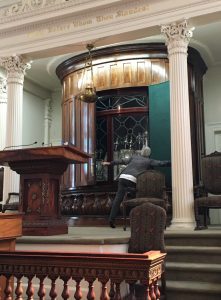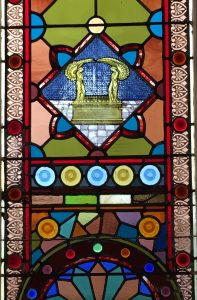Standing at Sinai – A Weekly Letter From Rabbi Davis – May 18, 2018
Shalom Chaverim,
In the Charleston synagogue, Kahal Kadosh Beth Elohim, we toured the sanctuary. We sat in the family pews of America’s fourth oldest Jewish congregation, admired the stained glass and woodwork and learned about the organ which was the impetus for a split between the reformers and the Sephardic founders. The story of the beautiful ark (pictured) was particularly interesting.
woodwork and learned about the organ which was the impetus for a split between the reformers and the Sephardic founders. The story of the beautiful ark (pictured) was particularly interesting.
Following the Reform custom of the day, the congregation prayed with the ark always open and the Torah scrolls exposed. Eventually, however, congregants felt uncomfortable being seated with the ark open. So they added a glass door to the ark to separate the Torah scrolls from the congregation. (America’s third oldest synagogue in Savannah, Mickve Israel, adopted the same practice.)
As you know, it is a tradition to stand when the ark is open. This shows honor to the Torah. On Shavuot, that custom is expanded to include standing during the reading of the Ten Commandments. Just as the Israelites stood at Sinai, we stand to reenact the Sinai moment. By standing, we demonstrate that we are receiving the Torah and reaffirming the covenant in our own day. But the practice is not without its controversy.
 Rambam objected to the custom of standing for the Ten Commandments. He worried that doing so would cause people to mistakenly believe that these verses were more important than the rest of the Torah. Rambam’s contemporaries did not share his concern. Neither do we. Standing for the Ten Commandments has become the universal custom not because this passage is the most important but because it demonstrates our acceptance of the entire Torah.
Rambam objected to the custom of standing for the Ten Commandments. He worried that doing so would cause people to mistakenly believe that these verses were more important than the rest of the Torah. Rambam’s contemporaries did not share his concern. Neither do we. Standing for the Ten Commandments has become the universal custom not because this passage is the most important but because it demonstrates our acceptance of the entire Torah.
Whatever our practice during the Torah reading, when we rise, we are called upon to “Know Before Whom Thou Stands!” This phrase is found above the ark of KKBE as it is above many synagogue arks. The words are not found in the Torah though they call to mind Moshe standing only holy ground before God at the burning bush. What does the saying mean?
This is not simply an admonishment to behave in shul- to stop talking to neighbors and to show reverence for the sanctuary. It calls upon us to direct our attention to God and to honor God by rising. It asks us to “know,” that is, to use our insight and deepen our awareness of God’s presence. It refers to God not as an object (before “what” you stand) but a presence (before “whom”). Finally, it directs us to stand. In that intimate position facing God, we display our statute and our strength, our pride and our vulnerability.
attention to God and to honor God by rising. It asks us to “know,” that is, to use our insight and deepen our awareness of God’s presence. It refers to God not as an object (before “what” you stand) but a presence (before “whom”). Finally, it directs us to stand. In that intimate position facing God, we display our statute and our strength, our pride and our vulnerability.
Whether our synagogue is nearing 100 years old like Beth El or almost 300 years old like KKBE, when we stand for the Torah reading on Shavuot, we are standing with a congregation that is over 3000 years old! So let us stand up, stand together and stand tall.
L’Shalom
Rabbi Alexander Davis
adavis@bethelsynagogue.org
